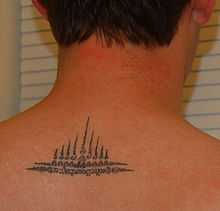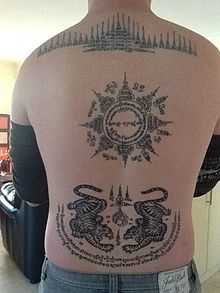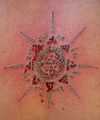Yantra tattooing

Yantra tattooing, also called sak yan (Thai: สักยันต์,[1] Khmer: សាក់យ័ន្ត, Burmese: တက်တူးထိုး), is a form of tattooing that originated in ancient Cambodia, yet almost completely vanished due to the civil war. Khmer yantra remains to be the most genuine and pure. It consists of magical ancient Khmer scripts that protect and give luck to the soul. It is practiced in Southeast Asian countries including Laos, Thailand and Burma. The practice has also begun to grow in popularity among Chinese Buddhists in Singapore.[2] Sak means "to [tattoo]", and yan is Thai for the Sanskrit word yantra.[3]
Sak yan designs are normally tattooed by ruesi, wicha (magic) practitioners, and Buddhist monks, traditionally with a long bamboo stick sharpened to a point (called a mai sak) or alternatively with a long metal spike (called a khem sak).[4]
History
Unlike in the Western world, where the rise of monotheist religion marked the decline of sacred tattoos, in Southeast Asia the practice spread with the arrival of Buddhism from India. However, in the Theravada Buddhist countries of Southeast Asia the majority of the people have remained animists at heart. Indeed, in the rural world and in the poorer areas at the periphery of the cities, Buddhist beliefs are combined with magical animism. For these people, religion is closely tied to the notion of magic, health, and good fortune.[5]
Yantra tattooing originated in Cambodia with the use of ancient Khmer script. In the Khmer Empire, Khmer warriors covered themselves with tattoos from head to toe, including their chest, arms, and even fingers. It was thought that this made them impervious to harm.
King Jayavarman VII, tested this with his own body. When struck by arrows all hits bounced off his chest, as recorded in the diary of Zhou Daguan.
Chinese chronicles describe yantra tattooing among the Khmer cultures of southwestern China and northwestern Vietnam at least 2,000 years ago. Over the centuries the tradition spread to what is now Thailand, Laos, Cambodia, and parts of Myanmar. Today it is most popular in Thailand, whereas in the country of origin, Cambodia, the tradition has almost completely vanished due to the wars killing millions.
The script used for yantra designs varies according to culture and geography. In Cambodia and central Thailand, pure ancient Khmer script is used, while in northern Thailand one sees yantra tattoos bearing Shan, northern Thai, or Tai Lu scripts, and in Laos the Lao Tham script is employed.[6] The script spells out abbreviated syllables from Pali incantations. Different masters have added to these designs over the centuries through visions received in their meditations. Some yantra designs have been adapted from pre-Buddhist shamanism and the belief in animal spirits that was found in Southeast Asia and incorporated into Thai tradition and culture.

Meaning
Yantra tattoos are believed to be magic and bestow mystical powers, protection, or good luck.[4]
In Cambodia, the tattoo is used for protection.[7] Cambodians believe a yantra has magical powers that ward off evil and hardship. The tattoo is particularly popular among military personnel. The tattoo supposedly guarantees that the person cannot receive any physical harm as long as they observe certain rules.
It is believed that the power of sacred tattoos decreases with time. So, to re-empower them each year, sak yan masters celebrate with their devotees the Wai Khru ritual. Wai khru, means "pay homage to one's teacher". In Thailand, the most impressive Wai Khru is held at the temple of Wat Bang Phra.[8]
Sak yan designs are also applied to many other media, such as cloth or metal, and placed in one's house, place of worship, or vehicle as a means of protection from danger or illness, to increase wealth, and to attract lovers.
Types and designs
There are many traditional types and designs of yantra tattoos, but some of the most well-known and popular include:
- Ohng Phra (Thai: องค์พระ translation: Buddha's body) - one of the most commonly used elements in Yantra tattooing, but can also be a more complex standalone design. Meant to provide insight, guidance, illumination, etc.
- Ha-thaeo (Thai: ห้าแถว translation: five rows) - Typically tattooed on the back left shoulder. Each of the five lines relates to a different blessing for success and good luck.
- Kao-yot (Thai: เก้ายอด translation: nine spires) - typically tattooed on the center top of the back in various sizes and levels of complexity. Simple version pictured at the top of this article.
- Si-yot (Thai: สี่ยอด translation: four spires) - to influence the feelings or actions of others and protect the bearer.
- Paet-thit (Thai: แปดทิศ translation: eight points) - represents protection in the eight directions of the universe. Round shape; typically tattooed on the center of the back. Pictured in gallery below.
- Sip-thit Thai: สิบทิศ(translation: ten points) - a version of paet-thit, but protects in ten directions instead of eight.
- Mahaaniyohm (Thai: มหานิยม (translation: great preference) - to grant the bearer favor in the eyes of others. Round shape; typically placed on the back right shoulder.[9]
- Yot Mohnggoot (Thai: ยอดมงกุฎ translation: spired crown) - for good fortune and protection in battle. Round shape; typically tattooed on the top of the head.
- Bpanjamukhee (translation: five Deva faces) - intended to ward off illness and danger.[10]
- Suea (Thai: เสือ translation: tiger) - typically depicts twin tigers. Represents power and authority.
Locations
Many internet sites recommend Thailand as the place to attain the most refined ritual tattoos and consider the country as the most popular for learning this art. Yet the most sacred and pure yantras can be done in the country of origin, Cambodia. Thailand and other Southeast Asian countries use ancient Cambodian scripts in the sacred art. Every year, hundreds of foreigners in search of original and magical tattoos come to Cambodia to have their tattoos done.[11] In Southeast Asia, Cambodia is by far the country with the highest number of devotees. Yantra is performed across the country in various temples located in Phnom Pehn, Battambang, Siem Reap, and many other locations.
- One of the most famous temples in the present day for yantra tattooing is Wat Bang Phra in Nakhon Chaysri, Nakhon Pathom Province, Thailand. Ajarn Noo Kanpai, perhaps the most famous practitioner of sak yan in Thailand, trained here.
- One well-known temple in northern Thailand is Wat Nhong Khem ("khem" means "needle").[12] It is in San Patong just outside Chiang Mai and was home to the late sak yan master Phra Ajarn Gamtawn, who died in Chiang Mai on 14 September 2010.[13]
- In the Lum Phli area on the north side of Ayutthaya, Ajarn Kob and his son, Ajarn Oh, are well-known sak yan masters.
Gallery
-

Yan Paet-thit
-

Hlwong Pi Nan tattooing yan at Wat Bang Phra Temple
-

Hlwong Pi Pant tattooing a yan in Ang Thong Province.
-

Devotee of Wat Bang Phra covered in yan tattoos
-

Sak yan, Nakhon Pathom
References
- ↑ "สักยันต์". thai-language.com. Retrieved 2015-02-05.
- ↑ http://www.buddhistchannel.tv/index.php?id=57,8938,0,0,1,0
- ↑ http://www.sak-yant.com/archive/108yant/
- ↑ 4.0 4.1 http://www.thaiguidetothailand.com/magic-and-superstition/sak-yant-magic-tattoo/
- ↑ Drouyer, Isabel Azevedo; Drouyer, Rene, (2013) Thai Magic Tattoos, The Art and Influence of Sak Yant, Riverbooks editions.
- ↑ http://www.sacredtattoosofthailand.com
- ↑ http://www.leisurecambodia.com/Leisure_Cambodia/No.17/tattoo.html
- ↑ Drouyer Isabel; Drouyer, Rene. Thai Magic Tattoos The Art and Influence of Sak Yant. River Books, 2013, p.99.
- ↑ http://www.sak-yant.com/?page_id=2150
- ↑ http://www.sak-yant.com/?page_id=2153
- ↑ http://www.tattoos-tattoos.com/book-preview.html
- ↑ http://northernthailand.com/a/en/chiangmai-cultural/tattoos/214-sak-yat-at-wat-kheam.html
- ↑ http://www.thaiguidetothailand.com/magic-and-superstition/phra-ajarn-gamtorn-sak-yant-chiang-mai-r-i-p/
External links
- AmuletForums | Discussion on Thai Spiritual Tattoos
- Tattoo Thailand | Info about Sak Yan, Yan Meanings, and List of Ajarn Sak Yan
- Sak Yan Thai Khmer Buddhist Temple Tattoos
- Sak Yant: Magic Tattoo
- Sak Yan Foundation & Museum Project
Further reading
- Chean Rithy Men. "The Changing Religious Beliefs and Ritual Practices among Cambodians in Diaspora", in Journal of Refugee Studies. Vol. 15, No. 2 2002, pp 222–233.
- Cummings, Joe. Sacred Tattoos of Thailand: Exploring the Masters, Magic and Mystery of Sak Yan. Singapore, 2011.
- Drouyer, Isabel; Drouyer, Rene. Thai Magic Tattoos The Art And Influence of Sak Yant. Ed. River Books, 2013.
- Harris, Ian. Cambodian Buddhism: History and Practice. Honolulu, 2008.
- Igunma, Jana. "Human Body, Spirit and Disease; the Science of Healing in 19th century Buddhist Manuscripts from Thailand", in The Journal of the International Association of Buddhist Universities. Vol. 1, 2008, pp. 120–132.
- Rivers, Victoria Z. "Layers of Meaning: Embellished Cloth for Body and Soul", in Jasleen Dhamija, Asian Embroidery. New Delhi, 2004, pp. 45–66. ISBN 81-7017-450-3.
- Swearer, Donald K. Becoming the Buddha: the Ritual of Image Consecration in Thailand. Princeton, 2004.